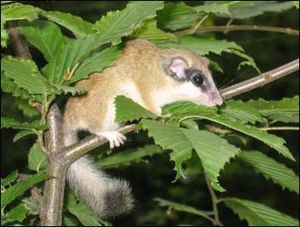Leithiinae facts for kids
Quick facts for kids Leithiinae |
|
|---|---|
 |
|
| Dryomys nitedula | |
| Scientific classification | |
| Kingdom: | |
| Phylum: | |
| Class: | |
| Order: | |
| Family: | |
| Subfamily: |
Leithiinae
Lydekker, 1896
|
| Genera | |
The Leithiinae are a group of small, furry animals called dormice. They are a subfamily, which is like a smaller group within a larger family. Think of it like different types of apples (the subfamily) all belonging to the apple family (the larger family). These dormice are known for being mostly active at night and for often sleeping a lot, especially during winter.
Contents
What are Dormice?
Dormice are small rodents, similar to mice or squirrels, but they belong to their own special family called Gliridae. Many dormice are famous for their long periods of hibernation, where they sleep through the cold months to save energy. They can be found in different parts of the world, including Europe, Asia, and Africa.
Where Leithiinae Dormice Live
Dormice in the Leithiinae subfamily live in various habitats. You can find them in forests, woodlands, and even rocky areas. They are good at climbing and often spend their time in trees and bushes. Their homes can be in tree hollows, old bird nests, or even underground burrows.
What Leithiinae Dormice Eat
Most dormice in this group are omnivores, meaning they eat both plants and small animals. Their diet often includes:
- Fruits
- Nuts
- Seeds
- Insects
- Bird eggs
They are very good at finding food, especially at night when they are most active.
Types of Leithiinae Dormice
This subfamily includes several interesting types of dormice. Here are a few examples:
- Dryomys: These dormice, like the Forest dormouse, are often found in forests. They are known for their quick movements and ability to climb trees easily.
- Eliomys: This group includes the Garden dormouse. They are a bit larger than some other dormice and have distinctive markings around their eyes.
- Muscardinus: The Hazel dormouse is one of the most well-known dormice. It's tiny and has soft, golden-brown fur. It's often found in hedgerows and woodlands.
- Selevinia: Unlike most dormice, the Desert dormouse lives in dry, desert-like areas. It has a very unique appearance with large ears and a long tail.
Life Cycle and Reproduction
Leithiinae dormice usually have their babies in the warmer months, often from spring to late summer. After mating, the female dormouse will build a cozy nest, sometimes in a tree hollow or a dense bush. She gives birth to a litter of tiny, helpless pups. The number of babies can vary, but it's usually between 2 and 7.
The mother takes care of the young, feeding them milk until they are old enough to start exploring and finding their own food. The young dormice grow quickly and become independent within a few weeks. Many dormice will then prepare for their long winter sleep, or hibernation, when the weather turns cold and food becomes scarce.
References
- Holden, M. E.. 2005. Family Gliridae. Pp. 819-841 in Mammal Species of the World a Taxonomic and Geographic Reference. D. E. Wilson and D. M. Reeder eds. Johns Hopkins University Press, Baltimore.
See also
 In Spanish: Leitinos para niños
In Spanish: Leitinos para niños

